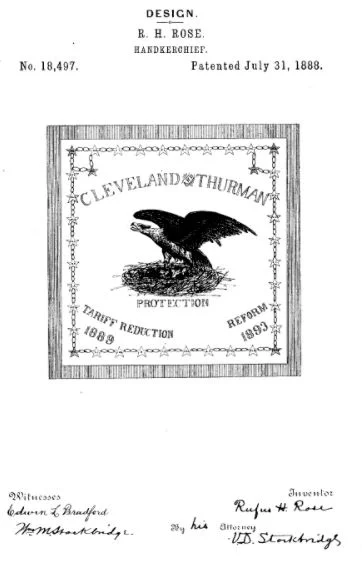Harrison and Morton Campaign Bandanna | One of the Most Striking Nineteenth Century Textiles Ever Produced | Circa 1888
Harrison and Morton Campaign Bandanna | One of the Most Striking Nineteenth Century Textiles Ever Produced | Circa 1888
Price: Call 618-553-2291, or email info@bonsellamericana.com
Frame Size (H x L): 33.5” x 34.5”
Bandanna Size (H x L): 23.5” x 24.5”
Offered is a patriotic campaign bandanna for the Harrison and Morton campaign of 1888. It is made of cotton, and vividly features an eagle protecting its three babies. The babies are resting in a nest and positioned in front of a rock. Printed above the eagle is the verbiage “1888” and “1892” in red, and the verbiage “HARRISON & MORTON” in black. Printed below the eagle are the themes of the Harrison campaign, including the verbiage “PROTECTION” in red, and the verbiage “CIVIL SERVICE REFORM” and “REDUCTION OF SURPLUS” in black. Thirty-nine states, encased by blue stars, are printed along the borders of the bandanna. Of particular note, one of the states is “DAK,” as this bandanna was made before it was known that there would be both a North Dakota and a South Dakota, instead of just one overall state.
Campaign bandannas were initially produced beginning in the first quarter of the nineteenth century, and became a particularly popular campaign tool in the time period between 1850 and 1920. Campaign bandannas were worn, presented in store fronts, waved in parades, flown at political rallies, and hung from buggy whips.
An example of this Harrison and Morton bandanna is documented in the Threads of History. The referenced example is shown as item 581 and was held in a private collection. In addition, this bandanna is also featured on the cover, along with eleven other special textiles. The Threads of History was written by Herbert Ridgeway Collins, who was the curator of the Division of Political History at the Smithsonian Institute. His book is the best reference available for political textile collectors and includes over fifteen-hundred examples, dating from 1775 to 1979.
The imagery shown on this bandanna is similar to the imagery protected in design patent number 18,497. Rufus H. Rose of New York, New York was listed as the sole inventor, and his patent issued on July 31st, 1888. The illustration in the ‘497 patent is actually for Cleveland & Thurman, and interestingly this example is not included in the Threads of History. To our knowledge and that of others, the Cleveland & Thurman textile may not have been distributed.
Harrison was a moderate Republican, and elected the 23rd president in the election of 1888. Harrison ran against Grover Cleveland, the incumbent President and a Democrat. Harrison lost the popular vote, but won the electoral vote with 233 electoral votes to Cleveland's 168. Harrison signed into law the Sherman Antitrust Act in 1890, the first legislation prohibiting business combinations in restraint of trade. Despite this, many Americans viewed Harrison and the Republicans as being too closely aligned with the wealthy elite, and as wasteful. Upon Harrison's election, the treasury had a great surplus, but the "Billion-Dollar Congress" spent enormous sums on soldiers' pensions and business subsidies, erasing the surplus. By 1890, the Democrats recaptured the House of Representatives by a large majority, and in turn, Harrison had little influence on legislation. In the election of 1892, Harrison lost the electoral vote with 145 electoral votes to Cleveland's 277.
Conservation Process: This bandanna was hand sewn to cotton fabric, and both were hand sewn to a mounting board. To prevent the black dye in the cotton fabric from seeping into the bandanna, it was first washed in a standard wash and then in a dye setting wash. The bandanna is positioned behind Conservation Clear Acrylic (standard) or behind Optium Museum Acrylic (per request).
Frame: This offering is in our Large Distressed Black and Gold Frame. However, it can be reframed and would look great using any one of our Medium or Large Frames, which are shown in the final two images. The pricing associated with the different framing options may vary. Reframing of an offering may delay shipment by up to two weeks.
Condition Report: This bandanna has some minor stains, most of which are light yellow in color. Despite this, it presents very well and is a statement piece.
Collectability Level: The Best – Perfect for Advanced Collectors
Date of Origin: 1888












